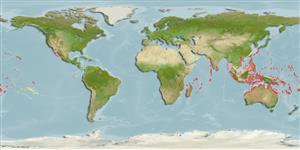>
Eupercaria/misc (Various families in series Eupercaria) >
Labridae (Wrasses) > Corinae
Etymology: Thalassoma: Greek, thalassa = the sea + Greek, soma = body; the colour of the sea (Ref. 45335).
More on author: Lacepède.
Environment: milieu / climate zone / depth range / distribution range
Ecologia
marinhas associadas(os) a recifes; intervalo de profundidade 0 - 10 m (Ref. 1602). Tropical; 30°N - 28°S
Indo-Pacific: East Africa to the Pitcairn, north to the Ryukyu Islands, south to Tonga and Rapa.
Tamanho / Peso / Idade
Maturity: Lm ? range ? - ? cm
Max length : 30.0 cm TL macho/indeterminado; (Ref. 4392)
Espinhos dorsais (total): 8; Raios dorsais (total): 13; Espinhos anais 3; Raios anais : 11. This species is distinguished by the following characters: greatest body depth 2.7-3.6 in SL; pectoral fin rays usually 16; lateral line scales 25; total gill rakers on first gill arch 17-24 (modally 20); caudal fin of initial phase slightly rounded to truncate, of terminal males truncate to slightly double emaginate; Body of initial (female) phase greenish grey to pale green with 5-6 dark saddles on back, pair of dark (sometimes diffused) stripes on side, a dark vertical line on most scales of body, and with a diagonal (or C-shaped) pink to dark red below front of eye; while body of terminal male salmon-pink to orange anteriorly, with 2 longitudinal series of vertical green rectangles, every fourth pair of upper series extending as a single green bar across back, the head orange-brown without bands and caudal fin brownish to greenish, shading distally to pink, the posterior third of rays blue (Ref. 9823, 86689, 90102).
Found solitary or in groups (Ref. 90102) in shallow exposed reef flats, usually with rock-base and mixed coral and algae (Ref. 48636, 58302). Also occurs in surge-swept reef flats, reef margins, and clear rocky shorelines, but may venture to deeper waters up to 10 m (Ref. 3921). Benthopelagic (Ref. 58302). Feeds on crustaceans (especially crabs), mollusks, and ophiuroids (brittle stars) (Ref. 3921).
Ciclo de vida ou comportamento de acasalamento
Maturidade | Reprodução | Desova | Ovos | Fecundidade | Larvas
Oviparous, distinct pairing during breeding (Ref. 205).
Randall, J.E., G.R. Allen and R.C. Steene, 1990. Fishes of the Great Barrier Reef and Coral Sea. University of Hawaii Press, Honolulu, Hawaii. 506 p. (Ref. 2334)
Status na Lista Vermelha da UICN (Ref. 130435)
Ameaça para os humanos
Harmless
Uso pelos humanos
Warning: mysqli::__construct(): (08004/1040): Too many connections in /var/www/html/includes/func_getlabel.php on line 46
Can't connect to MySQL database (fbapp). Errorcode: Too many connections
